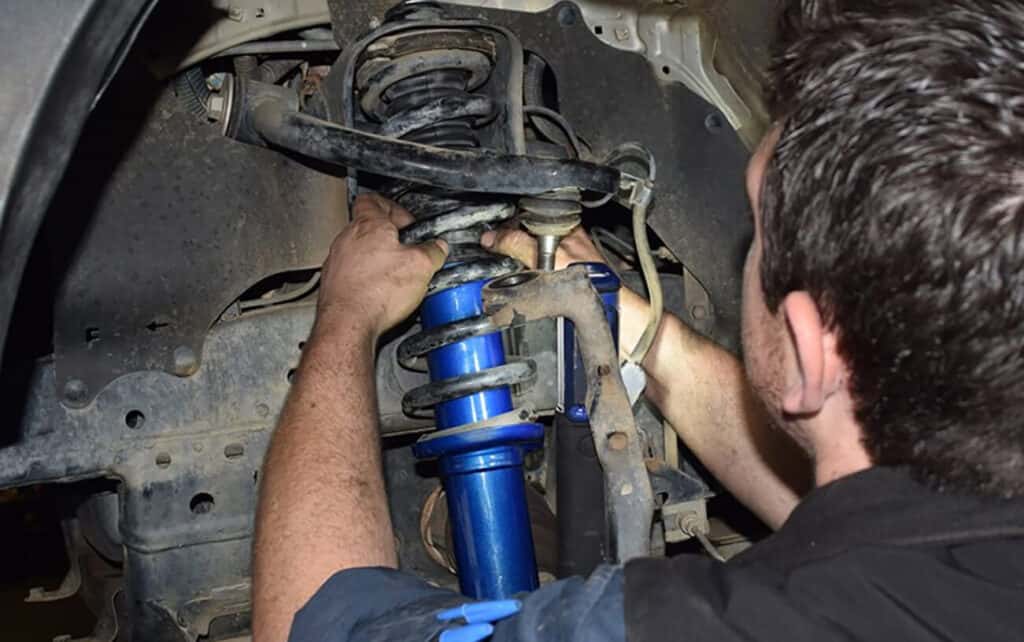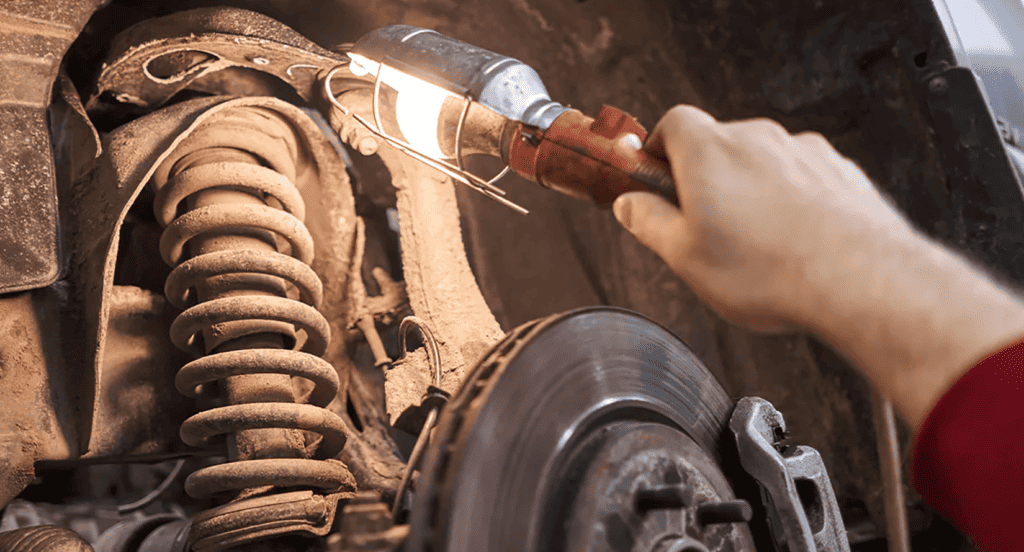Rolling Up the Garage Door on Shock Absorber and Struts Maintenance
Consider this article a friendly garage chat—a little more comprehensive, perhaps. Your vehicle’s shock absorbers and struts are crucial, yet they’re often overlooked, like the bass guitarist in a rock band. Understanding their maintenance is not just for gearheads but for anyone who values a smooth ride and, more importantly, their safety.
The Nuts and Bolts: How Shock Absorbers and Struts Work
When it comes to the mechanics of a vehicle, shock absorbers and struts serve as the unsung heroes, diligently working to keep your drive smooth and safe. They’re an integral part of your car’s suspension system, which is like the car’s very own “comfort and control” department. While it’s easy to take a smooth ride for granted, what you’re really experiencing is the result of an intricate dance between these parts and the road.
Shock absorbers are essentially hydraulic pumps that can convert kinetic energy into thermal energy. When your car bounces over a pothole, the shock absorbers take the kinetic energy generated by the springs moving up and down and turn it into heat, which is then dissipated. Struts, on the other hand, are a structural part of the suspension system. They integrate the shock absorber into a unit that also includes a coil spring, thereby serving a dual function.
But it’s not just about comfort. The unsung virtue of shocks and struts lies in their contribution to driving safety. They ensure that your tires are always in contact with the road. If you’ve ever tried to take a high-speed corner without properly functioning shocks or struts, you’ll notice your tires lose contact with the road, making steering almost ineffective. That’s not a situation anyone wants to find themselves in.
The effectiveness of these components can erode over time due to regular wear and tear, so it’s critical to understand their function and importance. By keeping an eye out for signs of wear and performing regular maintenance, you’re not just securing a comfortable ride; you’re ensuring the stability and safety of your vehicle.

Highway to Danger: The Risks of Neglecting Maintenance
It’s tempting to cut corners when it comes to car maintenance, especially with parts that don’t readily show their wear and tear like shocks and struts. However, the costs of neglecting these crucial elements are much higher than any money saved upfront. Imagine driving your car like an acrobat walking a tightrope; now remove the safety net below. That’s the kind of risk you’re running when you neglect these key components of your car’s suspension system.
Worn-out shocks and struts can have several adverse effects that go beyond the inconvenience of a less comfortable ride. First, they can significantly compromise your vehicle’s handling and stability. This becomes crucially dangerous when you have to make sudden stops or quick turns. Statistics indicate that poor shocks and struts can increase your stopping distance by up to 20%, which could be the difference between avoiding an accident and becoming part of one.
Moreover, poorly maintained shocks and struts can accelerate the wear and tear on other vehicle parts, such as tires and brakes, thereby shortening their lifespan and adding to your long-term expenses. Neglecting these components can also lead to more significant damage to your vehicle’s suspension system, turning what would have been a relatively straightforward fix into a complex and costly repair.
A Mechanic’s Checklist: Routine Inspections and Red Flags
Think of this section as the condensed version of a mechanic’s service manual. Key indicators that your shocks and struts need immediate attention include:
• Leaking Fluid: Examine your shock absorbers and struts for any oil or fluid leaks. This is usually a clear indicator of wear or damage.
• Uneven Tire Wear: Check the condition of your tires. If you notice uneven wear, especially on the inner or outer edges, it may indicate an issue with your shocks or struts.
• Vibrating Steering Wheel: Pay attention to the feel of your steering wheel. If it vibrates or seems less responsive, consider it a sign to consult a mechanic.
• Bouncier Ride: If your ride feels more like a roller coaster than a leisurely Sunday drive, your shock absorbers or struts may need attention.
• Strange Noises: Listen carefully while driving, especially over bumps or around corners. Sounds like knocking, rattling, or squeaking can signify a problem.
• Routine Inspections: These should be done at least every 20,000 km. It should involve checking for fluid leakage, examining for corrosion, and assessing the condition of rubber bushes.
• Visual Inspection: Sometimes a simple visual examination can reveal corrosion, dents, or other physical damages to the shocks and struts.
• Professional Diagnosis: When in doubt, always consult a professional for a detailed inspection and diagnosis, especially before long journeys or after an accident.
DIY Maintenance Tips: Simple Checks You Can Do at Home
The Bounce Test
Find a safe and level area to park your vehicle. Push down on each corner of the car. Observe how many times the car bounces. More than two bounces may indicate worn-out shocks or struts.
Visual Inspection for Leaks or Damage
Use a flashlight for a better view. Check for any leaking fluids or visible damages such as dents and corrosion.
Monitor Ride and Handling
Take note of any changes in how your vehicle rides or handles. Watch out for a harder or softer ride, or if the vehicle pulls to one side when driving.
Check for Noise
Listen for any unusual noises when driving, particularly over bumps or during turns. If any odd sounds are heard, consider it a red flag for further inspection.
Debunking Myths: Common Misconceptions About Shocks and Struts
Myth #1: Shock Absorbers and Struts are the Same
The Reality: It’s a common misconception to use the terms “shock absorbers” and “struts” interchangeably, but they serve different functions in your car’s suspension system. While both are designed to control excessive spring motion, shock absorbers can’t bear any of the vehicle’s weight. Struts, on the other hand, are a structural component of the suspension system and do bear weight. So, no, they aren’t the same thing and aren’t always interchangeable in vehicle repairs.
Myth #2: Replace Only When Leaking
The Reality: Many people believe that shocks and struts only need to be replaced when they start leaking hydraulic fluid. While leaks are a surefire sign that replacement is needed, mechanical wear can occur without visible leaks. And guess what? By the time a leak is visible, you might already be overdue for a replacement, posing a potential risk to your vehicle’s stability and your safety.

Myth #3: A Bumpy Ride Isn’t a Big Deal
The Reality: Some folks think that the primary role of shocks and struts is comfort, dismissing a bumpy ride as merely annoying rather than a safety concern. In fact, worn shocks and struts can compromise your vehicle’s handling, leading to a dangerous driving situation, particularly when sudden turns or stops are required.
Myth #4: All Shocks and Struts are Created Equal
The Reality: In the quest for cost-cutting, some people opt for generic or low-cost replacements, believing that all shocks and struts are basically the same. However, quality matters. Cheaper components may not meet the manufacturer’s specifications and could lead to poor vehicle performance or even cause damage to other parts of the suspension system.
Dollars and Wrenches: Typical Repair Costs and How to Budget for Them
• Cost Variability: Prices can range from $200 to $1,500 based on car model, type of repair, and location. Luxury cars generally have higher repair costs.
• Quality Over Price: Cheap isn’t always good. Low-cost parts may save you money in the short term, but they could lead to frequent replacements and even jeopardize safety.
• Include Labor Costs: Many forget to include labor costs when budgeting. These can sometimes match or even exceed the cost of parts.
• Manufacturer vs. Aftermarket Parts: Consider the pros and cons of using manufacturer-approved parts versus aftermarket options. The former usually comes with a warranty but is often more expensive.
• Budgeting Strategy: Set aside 1-2% of your monthly income specifically for car maintenance, including unexpected repairs. Treat it as a ‘rainy day fund’ for your vehicle.
• Scheduled Maintenance: Keep track of your next scheduled service and budget for it in advance. Scheduled services usually have a predictable cost range.
• Warranties and Coverage: If your car is new or if you have an extended warranty, check what kinds of repairs and parts it covers. It might save you from dipping into your budget.
Taking the Wheel with Confidence
Knowledge is your greatest tool in vehicle maintenance. Now that you’re armed with these insights, you’re better equipped to make informed decisions. If you need professional help, mobile mechanics like Uchanics provide convenient and reliable services right at your doorstep. By staying proactive, you’re not just ensuring a smooth ride but also taking the reins on your vehicle’s longevity and safety.
Ready to steer your way to better vehicle health? Visit Uchanics to book an appointment today.
